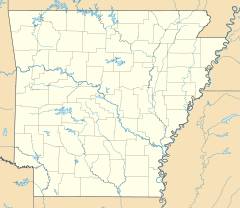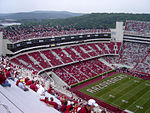- Arkansas Center for Space and Planetary Sciences
-
Arkansas Center for Space and Planetary Sciences 
The Old Field House at the U of A.Established 2000 Type Research Director Lin Oliver Location Fayetteville, Arkansas, USA 
Campus University of Arkansas Affiliations University of Arkansas Website http://spacecenter.uark.edu/ 
The Arkansas Center for Space and Planetary Sciences is a research center on the University of Arkansas campus in Fayetteville, Arkansas.
Contents
About the Space Center
Founded in 2000, the Space Center is a partnership of six departments (Biological Sciences, Chemical Engineering, Chemistry/Biochemistry, Geosciences, Mechanical Engineering, and Physics) from four colleges (Fulbright College, Engineering, the Honors College, and the Graduate School). It contains the W.M. Keck Laboratory for Planetary Simulation, which is used primarily for the study of Mars, asteroids and Titan.[1] The center also has an astronomy group, that specializes in galactic evolution, binary stars, and gravity waves, and it has groups interested in cosmochemstry, astrobiology, remote sensing, planetary morphology, and space flight instrument development. The Center offers two graduate degrees, a PhD and an MS in space and planetary sciences and four concentrations in space and planetary sciences in programs offered by its partnering departments.[2] The Space Center offers courses of research and instruction for undergraduate students and a variety of outreach programs for the public. The center owns a a 20 foot planetarium for teaching and outreach, which is currently out of operation. The Center also produces a monthly newsletter (Space Notes) and a quarterly publication, Meteorite.[3] The center recently celebrated its 10th anniversary. [1]
The center houses the Paragould meteorite, the third largest meteorite from north America, since 1988, except for a short period when it was in the Mullins Library.
Old Field House
Men's Gymnasium-University of Arkansas, FayettevilleLocation: Garland Ave., Fayetteville, Arkansas Coordinates: 36°4′10″N 94°10′33″W / 36.06944°N 94.17583°WCoordinates: 36°4′10″N 94°10′33″W / 36.06944°N 94.17583°W Built: 1935 MPS: Public Schools in the Ozarks NRHP Reference#: 92001103 [4] Added to NRHP: September, 1992 Since 2003 the Space Center has been housed in the old museum building, formerly the field house used for the Razorbacks basketball team until the construction of Barnhill Arena. The structure was added to the National Register of Historic Places in 1992.
References
- ^ "W.M. Keck Laboratory for Planetary Simulation." University of Arkansas. About Us. Retrieved April 5, 2010.
- ^ "Graduate Degrees in Space and Planetary Sciences." University of Arkansas. Degrees. Retrieved April 5, 2010.
- ^ "Meteorite Magazine." University of Arkansas. Magazine Profile. Retrieved April 5, 2010.
- ^ "National Register Information System". National Register of Historic Places. National Park Service. 2010-04-05. http://nrhp.focus.nps.gov/natreg/docs/All_Data.html.
External links
- University of Arkansas
- Arkansas Center for Space and Planetary Sciences
- W. M. Keck Laboratory for Space and Planteray Simulations
U.S. National Register of Historic Places Topics Lists by states Alabama • Alaska • Arizona • Arkansas • California • Colorado • Connecticut • Delaware • Florida • Georgia • Hawaii • Idaho • Illinois • Indiana • Iowa • Kansas • Kentucky • Louisiana • Maine • Maryland • Massachusetts • Michigan • Minnesota • Mississippi • Missouri • Montana • Nebraska • Nevada • New Hampshire • New Jersey • New Mexico • New York • North Carolina • North Dakota • Ohio • Oklahoma • Oregon • Pennsylvania • Rhode Island • South Carolina • South Dakota • Tennessee • Texas • Utah • Vermont • Virginia • Washington • West Virginia • Wisconsin • WyomingLists by territories Lists by associated states Other Preceded by
UnknownHome of Arkansas Razorbacks basketball
? – 1953Succeeded by
Barnhill ArenaCategories:- University of Arkansas
- Buildings and structures on the National Register of Historic Places in Arkansas
- 1935 architecture
- Buildings and structures in Fayetteville, Arkansas
Wikimedia Foundation. 2010.




